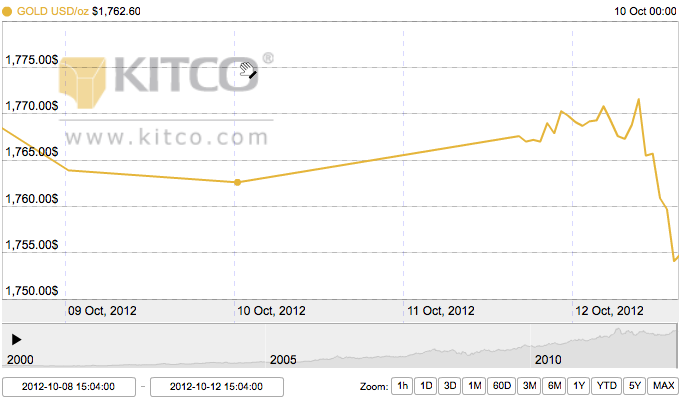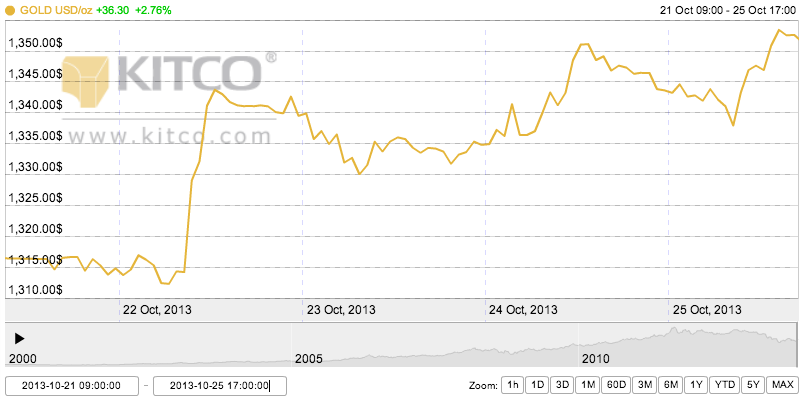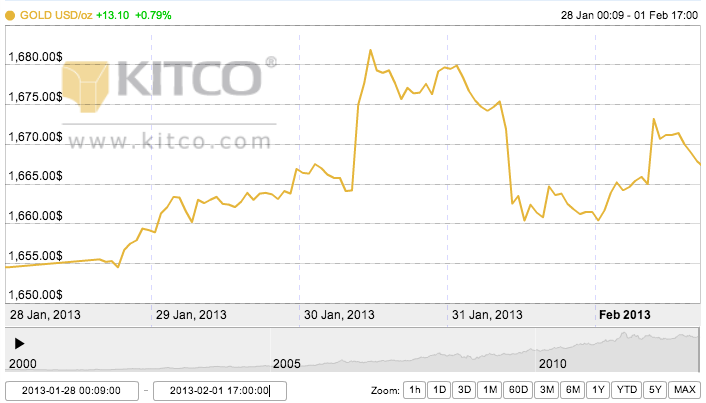Monday Open: $1,775.50
Weekly High: $1,775.50
Weekly Low: $1,754.10
Friday Close: $1,754.90

The price of gold this week fluctuated about $30 due to continuing uncertainty about the European debt crisis and the future of U.S. economic policy. Monday celebrated the American holiday of Columbus Day, so trading took a pause. There was slight risk-off trading, but the marketplace was quiet until Tuesday.
The yellow metal dropped about $10 on Tuesday after the International Monetary Fund lowered its predictions for world economic growth from 3.5% to 3.3%, reporting that the world’s industrial economies are at risk for a prolonged recession. Another reason for the drop on Tuesday was the ongoing conversation about Spain’s economic crisis, and uncertainty whether Spain really will ask for a bailout. After two days of meetings with eurozone finance ministers, no conclusion was reached and rioting continued in both Spain and Greece.
Last week, U.S. unemployment data revealed better than expected numbers, reporting that unemployment had dropped to 7.8%, so there is also some uncertainty for gold in this arena. Even though gold took a high turn a few weeks ago after Federal Reserve Chairman Ben Bernake agreed to third quarter quantitative easing, there is no guarantee how long his looser economic policies will last; the low interest rates and mortgage incentives are in place only until the U.S. labor market can show significant improvement.
Still, gold hovered in the upper $1,700 range this week. Wednesday was a general day of trading limbo, as some traders decided to sell off to reduce risk amid economic uncertainty, but the price remained fairly steady.
Thursday saw a slight jump for gold when U.S. economic data reported slightly higher jobless claims. Spain also had their credit score knocked down two points by credit rating agency Standard & Poor, but surprisingly the euro did not respond, and many continue to be optimistic that Spain will opt for a bailout.
It seems as if the U.S. if the major indicator of gold’s track upward or down, even though European and Chinese economies definitely play a hand in the cards. Still, the Fed’s decision to loosen monetary policy has been the singlemost significant factor for gold this year.
Stock market analyst Tom Kendall of Credit Suisse said, “Gold is going to take its biggest cue, as it has for the most recent past, from what happens in the U.S. in respect to the strength of the economic recovery and what that means for monetary policy.” He went on to say that it is fairly hard to predict the effect U.S. joblessness claims will have on gold now due to seasonality.
To recap the year so far, gold has risen about $215, or 13%, in 2012 with a majority of those gains, $165, occurring in the pas two months due to Fed monetary policy. Friday ended slightly lower but fairly quietly in trade-off anticipation of the weekend. Most polls show an even split as to how gold will perform next week.


